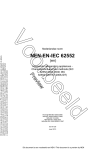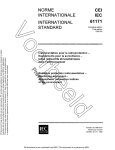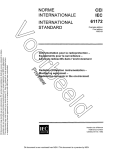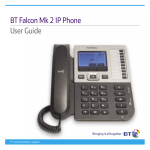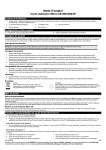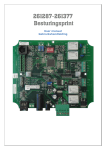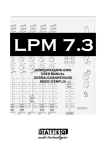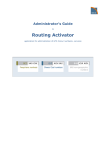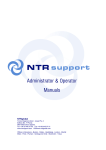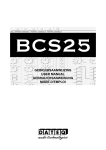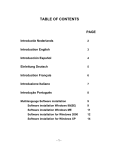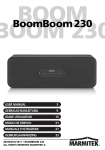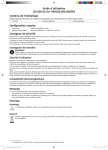Download Preview
Transcript
INTERNATIONAL STANDARD ISO/IEC 19752 First edition 2004-06-15 Corrected version 2004-09-15 Technologies de l'information — Méthode pour la détermination du rendement des cartouches de toner pour les imprimantes électrophotographiques monochromatiques et pour les dispositifs multifonctionnels qui contiennent des composants d'imprimantes be iew ev Pr eld Dit document mag slechts op een stand-alone PC worden geinstalleerd. Gebruik op een netwerk is alleen. toestaan als een aanvullende licentieovereenkomst voor netwerkgebruik met NEN is afgesloten. This document may only be used on a stand-alone PC. Use in a network is only permitted when a supplementary license agreement for us in a network with NEN has been concluded. or Vo Information technology — Method for the determination of toner cartridge yield for monochromatic electrophotographic printers and multi-function devices that contain printer components Reference number ISO/IEC 19752:2004(E) © ISO/IEC 2004 Dit document is een voorbeeld van NEN / This document is a preview by NEN ISO/IEC 19752:2004(E) PDF disclaimer This PDF file may contain embedded typefaces. In accordance with Adobe's licensing policy, this file may be printed or viewed but shall not be edited unless the typefaces which are embedded are licensed to and installed on the computer performing the editing. In downloading this file, parties accept therein the responsibility of not infringing Adobe's licensing policy. The ISO Central Secretariat accepts no liability in this area. Adobe is a trademark of Adobe Systems Incorporated. Details of the software products used to create this PDF file can be found in the General Info relative to the file; the PDF-creation parameters were optimized for printing. Every care has been taken to ensure that the file is suitable for use by ISO member bodies. In the unlikely event that a problem relating to it is found, please inform the Central Secretariat at the address given below. be iew ev Pr or Vo eld © ISO/IEC 2004 All rights reserved. Unless otherwise specified, no part of this publication may be reproduced or utilized in any form or by any means, electronic or mechanical, including photocopying and microfilm, without permission in writing from either ISO at the address below or ISO's member body in the country of the requester. ISO copyright office Case postale 56 x CH-1211 Geneva 20 Tel. + 41 22 749 01 11 Fax + 41 22 749 09 47 E-mail [email protected] Web www.iso.org Published in Switzerland ii © ISO/IEC 2004 – All rights reserved Dit document is een voorbeeld van NEN / This document is a preview by NEN ISO/IEC 19752:2004(E) Contents Page Foreword ............................................................................................................................................................ iv Introduction ........................................................................................................................................................ v Vo Scope...................................................................................................................................................... 1 2 Terms and definitions........................................................................................................................... 1 3 3.1 3.2 3.3 3.4 3.5 3.6 3.7 Test Parameters and Conditions......................................................................................................... 2 Set-up ..................................................................................................................................................... 2 Sample Size ........................................................................................................................................... 3 Print Mode.............................................................................................................................................. 3 Print Environment ................................................................................................................................. 3 Paper ...................................................................................................................................................... 4 Maintenance .......................................................................................................................................... 4 Print File ................................................................................................................................................. 4 4 4.1 4.2 4.2.1 4.2.2 Test Methodology ................................................................................................................................. 5 Testing Procedure................................................................................................................................. 5 Procedure for handling a defective cartridge or printer ................................................................... 5 Defective Cartridge ............................................................................................................................... 5 Defective Printer.................................................................................................................................... 5 5 5.1 5.2 5.3 Determination of the declared yield value and declaration .............................................................. 6 Determination of the declared yield value.......................................................................................... 6 Test data reporting................................................................................................................................ 6 Declaration of the yield......................................................................................................................... 6 be ev Pr or 1 Annex A (informative) Examples of Fade......................................................................................................... 7 iew Annex B (informative) Process Flowchart and Examples .............................................................................. 8 Annex C (normative) Standard test page....................................................................................................... 11 Annex D (informative) Sample reporting form............................................................................................... 16 Annex E (informative) Comparison of Yield for Two Printing Systems ...................................................... 18 eld © ISO/IEC 2004 – All rights reserved Dit document is een voorbeeld van NEN / This document is a preview by NEN iii ISO/IEC 19752:2004(E) Foreword Vo ISO (the International Organization for Standardization) and IEC (the International Electrotechnical Commission) form the specialized system for worldwide standardization. National bodies that are members of ISO or IEC participate in the development of International Standards through technical committees established by the respective organization to deal with particular fields of technical activity. ISO and IEC technical committees collaborate in fields of mutual interest. Other international organizations, governmental and non-governmental, in liaison with ISO and IEC, also take part in the work. In the field of information technology, ISO and IEC have established a joint technical committee, ISO/IEC JTC 1. International Standards are drafted in accordance with the rules given in the ISO/IEC Directives, Part 2. The main task of the joint technical committee is to prepare International Standards. Draft International Standards adopted by the joint technical committee are circulated to national bodies for voting. Publication as an International Standard requires approval by at least 75 % of the national bodies casting a vote. or Attention is drawn to the possibility that some of the elements of this document may be the subject of patent rights. ISO and IEC shall not be held responsible for identifying any or all such patent rights. ISO/IEC 19752 was prepared by Joint Technical Committee ISO/IEC JTC 1, Information technology, Subcommittee SC 28, Office equipment. be iew ev Pr This corrected version of ISO/IEC 19752:2004 incorporates the corrected title, which has been changed from “Information technology — Method for the determination of toner cartridge yield for monochromatic electrophotographic printers and multi-function devices that may contain printer components” to “Information technology — Method for the determination of toner cartridge yield for monochromatic electrophotographic printers and multi-function devices that contain printer components”. eld iv © ISO/IEC 2004 – All rights reserved Dit document is een voorbeeld van NEN / This document is a preview by NEN ISO/IEC 19752:2004(E) Introduction The purpose of this International Standard is to provide a process for determining the page yield for toner cartridges for monochromatic printers using a standard office consumer type test page. Vo This standard prescribes the following: x The test method that manufacturers should use to determine cartridge yield. x The method for determination of declared yield values from the test results. x The appropriate method of describing the yield of cartridges in documentation supplied to the consumer by the manufacturer. The end of life is judged with either of two phenomena - “image fade” caused by toner depletion of the cartridge in the printing system or "automatic printing stop" by the Toner Out detection function. be iew ev Pr or eld © ISO/IEC 2004 – All rights reserved Dit document is een voorbeeld van NEN / This document is a preview by NEN v be iew ev Pr or Vo eld Dit document is een voorbeeld van NEN / This document is a preview by NEN INTERNATIONAL STANDARD ISO/IEC 19752:2004(E) Information technology — Method for the determination of toner cartridge yield for monochromatic electrophotographic printers and multi-function devices that contain printer components Vo 1 Scope or The scope of this International Standard is limited to evaluation of toner cartridge yield for toner containing cartridges (i.e. all-in-one toner cartridges and toner cartridges without a photoconductor) for monochrome electrophotographic printers. This International Standard could also be applied to the printer component of any multifunctional device that has a digital input-printing path (i.e. multi-function devices that contain printer components). This International Standard is only intended for the measurement of toner cartridge yield. No other claims can be made from this testing regarding quality, reliability, etc. be Terms and definitions iew 2 ev Pr NOTE Application of this International Standard for yield measurement of toner replenishment systems (i.e. toner cartridge- and bottle type systems where the toner reservoir is internal to the printing system and not user-replaceable) requires some procedural modifications specifically noted herein. This International Standard is intended for equipment used in the office space and does not apply to production volume or large format printing machines where the major cost of ownership is not caused by the consumable yield measured in this International Standard. For the purposes of ISO 19752, the following terms and definitions apply. 2.1 Fade a phenomenon whereby a noticeable reduction in density uniformity across the page occurs eld NOTE In this test, fade is defined as a noticeably lighter, 3 mm or greater, gap located in the text or boxes around the periphery of the test page. The determination of the change in lightness is to be made referenced to the 100th page printed for each cartridge in testing. For examples of fade, please consult Annex A. 2.2 Shake Procedure in the case that the cartridge user’s manual instructs cartridge shaking and its method, shaking the cartridge according to the procedures specified NOTE If a shake procedure is used in testing it will be noted in the report. 2.3 Toner Low a signal generated by the printer when it has been detected that the amount of toner is such that a toner change will be required soon NOTE It does not indicate that the system is out of toner. © ISO/IEC 2004 – All rights reserved Dit document is een voorbeeld van NEN / This document is a preview by NEN 1 ISO/IEC 19752:2004(E) 2.4 Toner Out a signal generated by the printer when the toner in the system is depleted and the printer is incapable of reliable printing without user intervention NOTE For the purpose of this test, the toner out signal will only be used if it causes the printer to stop printing and requires toner replacement to continue printing. Vo 2.5 End of Life when the printer declares “Toner Out” NOTE 1 The general intent of this definition is to allow 2 shake procedures near end of life and to declare end of life at the first fade after the 2 shake procedures. Nominally the shake procedures are to be executed at print fade. However, if the printer is equipped with a Toner Low device, then the first, second or both shake procedures can be executed at Toner Low instead of at fade as a convenience for the tester. If the user’s guide does not specify a shake procedure then the shake procedures are not done and end of life occurs at the first fade. or NOTE 2 When fade occurs before Toner Out and no shake procedure is specified, then end of life is declared at the fade. If a shake procedure is specified for a printer with a Toner Out device, then up to 2 shake procedures can be executed as described in the paragraph above when fade occurs before Toner Out. In this case, if fade occurs after 2 shake procedures but before Toner Out, then end of life is declared at the third fade. If Toner Out occurs at any time during testing, the cartridge is considered to be at end of life. NOTE 3 When applied to replenishment systems (bulk toner replacement or multi-part toner systems), the intent of this definition is to declare a quasi-end of cartridge life at a regular predetermined point. If the printer is equipped with a Toner Low or Toner Out signal, these can be used as the point of quasi-end of life. In either case, the end of life condition chosen must be noted in the test report. be NOTE 5 ev Pr NOTE 4 When shake procedures have been performed during the test, the test report will note for both the first and second shake procedures whether they were done at Toner Low or at fade. Any faded pages printed during the test are to be excluded from the cartridge page count. Application of this definition may be clarified by reference to a flow chart and examples found in Annex B. iew 2.6 Individual Page Yield the number of “standard page file” pages printed between cartridge installation and end of life (as defined in Section 3.5) 2.7 Declared Page Yield (see Clause 6) 3 3.1 Test Parameters and Conditions Set-up eld NOTE For replenishment systems, the individual page yield is determined by counting the number of “standard page file” pages printed between prescribed quasi-end of life conditions (defined in Section 3.5). Place the printer on a horizontal surface and set-up the printer according to the installation guide provided in the printer user’s manual. Use the most recent printer driver available from the manufacturer. The driver version will be specified on the test report. Cartridge installation shall be completed following the instructions in the cartridge installation guide. If there is a contradiction between the printer and cartridge manuals for the cartridge installation, the cartridge manual will take precedence except if changes are recommended for printer or driver settings. If the cartridge used in testing is a toner replenishment or toner bottle type, then one complete toner cartridge will be used in each printer before the start of the test. The pages printed to deplete this priming cartridge do 2 © ISO/IEC 2004 – All rights reserved Dit document is een voorbeeld van NEN / This document is a preview by NEN ISO/IEC 19752:2004(E) not have to be recorded and printing can be conducted at any environment. This priming cartridge is used to bring the printing system to a set toner level condition. All image and print quality modifiers should be at their factory pre-set configuration for the printer and default installed condition for the driver. If the printer and driver differ, then the driver defaults should be used. Any user selectable toner conservation modes should be disabled during testing. If the printer under test uses an internal PDF interpreter, it is ok to use it as long as the printer defaults are set to not substitute fonts. If the internal interpreter is used, this should be noted on the report. Vo To assure that the test page is rendered correctly, any page size modifiers such as “Fit to Page”, “Page Centring” and font substitution should be turned off. To further insure that font substitution does not occur, fonts should be downloaded as TrueType fonts if the driver provides that option. If the option exists, rendering of graphics should be performed by the printer, not the application software or operating system. The file should be printed using the fonts embedded in the file and should be rendered on the page in a size corresponding to the dimensions in the test page description. Page placement modifies such as page centering can be used to place the image properly on the page. If there is a question about rendering settings affecting the yield, the setting should be noted in the report. NOTE The application software (i.e. Adobe Reader), printer driver and printer may have page size modifier functions, such as “Fit to Page”. Make sure that all of these functions are disabled. or 3.2 Sample Size be NOTE testing. 3.3 iew ev Pr A combination of at least three cartridges shall be run on a combination of at least three printers (for a minimum of nine cartridges and three printers). This is the minimum number of engines and cartridges that should be used for testing. When feasible it is recommended that additional engines and cartridges be used in testing. When testing additional engines and cartridges above the minimum, an effort should be made to test equal number of cartridges on each engine. For example, if an additional engine is to be tested then the minimum number of cartridges to be tested would be 12 (3 cartridges X 4 engines). When testing cartridges for a released product, it is recommended that cartridges and printers are procured from various sources, or selected from different production lots. The printers and cartridges must be within their useful life as stated in their user’s manual. It is recommended that an additional cartridge be procured to allow for the possibility of cartridge failure during Print Mode 3.4 Print Environment eld For reporting cartridge yield, the test shall be run in continuous print mode simplex printing, with printed output occurring at or near rated printer speed. The actual print speed will be semi-continuous because of printing being interrupted for paper replenishment etc. Every attempt should be made to have printing be continuous from the start of a cartridge to the end of cartridge life. The temperature and humidity can have a profound effect on test results. For this reason, the test must be carried out according to the following test conditions: Temperature: Testing room average 23.0C r 2C Readings to be made with a running average of 1 hour with readings recorded at least every 15 minutes, all running average temperatures are to be between 20.0C and 26.0C. Relative Humidity: Testing room average 50% r 10% RH Readings to be made with a running average of 1 hour with readings recorded at least every 15 minutes, all running average RHs are to be between 35% and 65%. © ISO/IEC 2004 – All rights reserved Dit document is een voorbeeld van NEN / This document is a preview by NEN 3 Bestelformulier Stuur naar: NEN Uitgeverij t.a.v. afdeling Marketing Antwoordnummer 10214 2600 WB Delft NEN Uitgeverij Postbus 5059 2600 GB Delft Vlinderweg 6 2623 AX Delft T (015) 2 690 390 F (015) 2 690 271 Ja, ik bestel __ ex. ISO/IEC 19752:2004-09 en Information technology - Method for the determination of toner cartridge yield for monochromatic electrophotographic printers and multi-function devices that contain printer components www.nen.nl/normshop € 98.05 Wilt u deze norm in PDF-formaat? Deze bestelt u eenvoudig via www.nen.nl/normshop Stel uw vraag aan Klantenservice via: @NEN_webcare Gratis e-mailnieuwsbrieven Retourneren Wilt u op de hoogte blijven van de laatste ontwikkelingen op het gebied van normen, Fax: (015) 2 690 271 E-mail: [email protected] Post: NEN Uitgeverij, t.a.v. afdeling Marketing Antwoordnummer 10214, 2600 WB Delft (geen postzegel nodig). normalisatie en regelgeving? Neem dan een gratis abonnement op een van onze e-mailnieuwsbrieven. www.nen.nl/nieuwsbrieven Gegevens Bedrijf / Instelling T.a.v. O M O V Voorwaarden • De prijzen zijn geldig tot 31 december 2015, E-mail tenzij anders aangegeven. • Alle prijzen zijn excl. btw, Klantnummer NEN verzend- en handelingskosten Uw ordernummer BTW nummer en onder voorbehoud bij o.m. ISO- en IEC-normen. Postbus / Adres • Bestelt u via de normshop een PostcodePlaats pdf, dan betaalt u geen handeling en verzendkosten. TelefoonFax • Meer informatie: telefoon (015) 2 690 391, dagelijks Factuuradres (indien dit afwijkt van bovenstaand adres) van 8.30 tot 17.00 uur. Postbus / Adres • Wijzigingen en typefouten in teksten en prijsinformatie PostcodePlaats voorbehouden. • U kunt onze algemene voorwaarden terugvinden op: DatumHandtekeningwww.nen.nl/leveringsvoorwaarden. Normalisatie: de wereld op één lijn. preview - 2015










